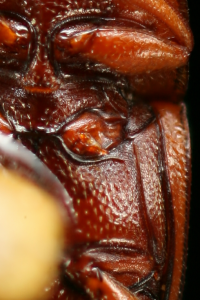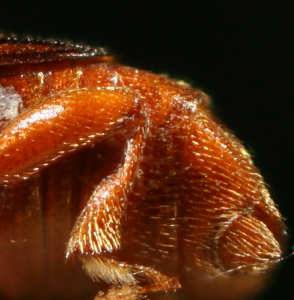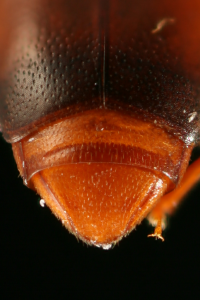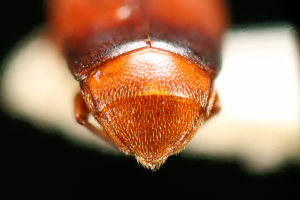Species Fact Sheet
Carpophilus antiquus Melsheimer, 1844
Diagnosis: Carpophilus antiquus specimens are distinguished from other eastern North American species by having the following combination of features: elytra with darker coloration near the apex only (Fig. 1 & 7), and an impunctate area near the center of the mesosternum (Fig. 3). The male metathoracic tibia is abruptly dilated apically (Fig. 5 & 6).
Distribution: Carpophilus antiquus is found in eastern North America from Quebec to Florida and west to Wisconsin, Iowa, Kansas, and Texas.
Biology: C. antiquus is most commonly associated with corn (Bartelt, Seaton, and Dowd 1993). It has also been collected fallen peaches, rotting melon, under Quercus sp. woodchips, under the bark of Pinus sp., in traps with banana and fermenting brown sugar, and other rotting fruit (Connell 1956; Price and Young 2006) Larvae illustrated and described by Connell (1956).
References:
Bartelt RJ, Seaton KL, Dowd PF (1993) – aggregation pheromone and association with corn
Connell WA (1956) – larvae and adult description, key to larvae and adults, and collection records
Price MB, Young DK (2006) – collection records
Double-click on images to enlarge

Figure 2. Male dorsal habitus

Figure 3. Mesosternum with impunctate area near center (ventral view)

Figure 4. Posterior rim of mesocoxal cavities, forming small axillary space extending approximately ¼ down metepisternal suture (ventral view)

Figure 5. Male metathoracic tibia shape, gradually abruptly dilated (anterior view)

Figure 6. Male metathoracic tibia shape, gradually abruptly dilated (anterior view)

Figure 7. Female pygidium (dorsoposterior view)

Figure 8. Male pygidium (dorsoposterior view)
HOW TO CITE THIS WORK:
DiLorenzo, C.L., G.S. Powell, A.R. Cline, and J.V. McHugh (2021) Carpophiline-ID, a taxonomic web resource for the identification of Carpophilinae (Nitidulidae) of eastern North America. (vers. 01.19.2021) University of Georgia, retrieved from https://site.caes.uga.edu/carpophiline-id/
